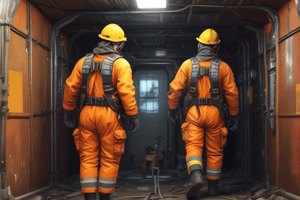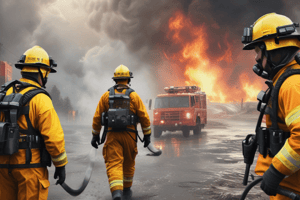Podcast
Questions and Answers
What is the primary purpose of the Threshold Limit Value – Short Term Exposure Limit (TLV-STEL)?
What is the primary purpose of the Threshold Limit Value – Short Term Exposure Limit (TLV-STEL)?
- To prevent irritation and chronic tissue damage from short-term exposure (correct)
- To determine the maximum daily exposure to a substance
- To establish a separate independent exposure limit
- To calculate the time-weighted average of a substance
What is the duration of a STEL exposure?
What is the duration of a STEL exposure?
- 60 minutes
- 30 minutes
- 15 minutes (correct)
- 8 hours
How many times can a STEL exposure be repeated in a day?
How many times can a STEL exposure be repeated in a day?
- Four times (correct)
- Two times
- Once
- Unlimited
What is the minimum time required between successive STEL exposures?
What is the minimum time required between successive STEL exposures?
What is the purpose of the Threshold Limit Value – Ceiling (TLV-C)?
What is the purpose of the Threshold Limit Value – Ceiling (TLV-C)?
When should a STEL be recommended?
When should a STEL be recommended?
What is the relationship between the STEL and the daily TLV-TWA?
What is the relationship between the STEL and the daily TLV-TWA?
Why is it important to consider combined threshold limit values in a mine?
Why is it important to consider combined threshold limit values in a mine?
What should be given primary consideration when two or more hazardous substances have a similar toxicological effect?
What should be given primary consideration when two or more hazardous substances have a similar toxicological effect?
What is the purpose of the TLV-STEL in relation to the TLV-TWA?
What is the purpose of the TLV-STEL in relation to the TLV-TWA?
Flashcards are hidden until you start studying
Study Notes
Size Up and Hazard Assessment
- Information gathered during size up is either factual (known or confirmed) or probable (assumptions made based on situation)
- Hazard assessment involves identifying and evaluating hazards that may be encountered during the rescue operation
- Hazards include:
- Fire
- Hazardous atmospheres (e.g., chemical hazards, toxic gases, oxygen displacement)
- Energy sources (e.g., electrical, gas, nuclear)
- Physical (e.g., structure, traffic, topography)
- Biological
- Environmental
- Evaluate all influencing factors (e.g., time, location, environment, weather)
Formulating an Objective
- Formulate an objective based on known information and resources
- Determine what resources are required to accomplish the task (e.g., offensive or defensive)
- Risk-based decision-making based on the fundamental principles of mine rescue
Selecting Alternatives and Taking Action
- Select one or more alternatives from the available options
- Choose priorities based on the task and the resources available
- Conduct all activities in a manner that ensures the safety of team members, casualties, and bystanders
- Analyze results and be prepared to choose an alternative action if results are unsatisfactory
Personal Protective Equipment (PPE)
- PPE is essential for mine rescue teams
- PPE has limitations that must be recognized to avoid overextension of protection
- Extensive training in the care, use, and maintenance of PPE is essential for optimum protection
Electrical Hazards
- Direct contact with power lines is not necessary to pose an arcing hazard
- Responders should know that electrical systems are used by welders and take steps to eliminate and/or mitigate hazards
- Crane operators should be aware of overhead power lines and take precautions to avoid contact
- Haul trucks may experience tire explosions during or after contact with power lines
Avalanche Awareness
- Mines operating in avalanche-prone areas must develop an avalanche emergency response plan
- Avalanche safety officer must be identified, consulted, and lead the safe emergency response
- An avalanche has three main parts: starting zone, track, and run-out zone
- Avalanche can occur anywhere given the right conditions (e.g., geography, snow accumulation on a moderate to steep slope)
Ice Travel and Safety
- Load reduction of at least 15% on clear or natural ice (black or blue hue)
- Slush ice (white hue) is weaker than clear blue lake-ice
- Cracks in ice may affect its ability to support a load
- Table shows maximum allowable mass of a vehicle in motion for ice of various thicknesses
Threshold Limit Value (TLV)
- TLV-STEL (Short Term Exposure Limit) is the concentration to which workers can be exposed for a short period without suffering from irritation, chronic or irreversible tissue damage, or narcosis
- TLV-STEL is not a separate independent exposure limit, but supplements the time-weighted average (TWA) limit
- TLV-C (Ceiling) is the concentration that should not be exceeded during any part of the working exposure
Studying That Suits You
Use AI to generate personalized quizzes and flashcards to suit your learning preferences.




